Porter-Cable PCE300 Handleiding
Porter-Cable
Zaagmachine
PCE300
Bekijk gratis de handleiding van Porter-Cable PCE300 (40 pagina’s), behorend tot de categorie Zaagmachine. Deze gids werd als nuttig beoordeeld door 10 mensen en kreeg gemiddeld 4.7 sterren uit 5.5 reviews. Heb je een vraag over Porter-Cable PCE300 of wil je andere gebruikers van dit product iets vragen? Stel een vraag
Pagina 1/40

7-1/4” (184mm), 15 AMP Circular Saw
Scie Circulaires 7-1/4” (184mm), 15 Ampère
Sierras Circulares de 184mm (7-1/4”), 15 Amperios
CATALOG NUMBER
N° DE CATALOGUE
CATÁLOGO N°
PCE300
Instruction manual
Manuel d’instructions
Manual de’instrucciones
www.portercable.com
INSTRUCTIVO DE OPERACIÓN, CENTROS DE SERVICIO Y PÓLIZA DE GARANTÍA.
ADVERTENCIA:
LÉASE ESTE INSTRUCTIVO ANTES DE USAR EL PRODUCTO.
Thank you for choosing PORTER-CABLE! To register your new product, go to:
www.portercable.com/ServiceAndSupport/ProductRegistration.aspx
Merci d’avoir choisi PORTER-CABLE! Consulter le site Web www.portercable.com/
ServiceAndSupport/ProductRegistration.aspx pour enregistrer votre nouveau produit.
Gracias por elegir PORTER-CABLE usted! Para registrar su nuevo producto, visite: www.
portercable.com / ServiceAndSupport / ProductRegistration.aspx

2
GENERAL POWER TOOL
SAFETY WARNINGS
WARNING:
Read all safety warnings
and all instructions. Failure to follow the
warnings and instructions may result in electric
shock, fire and/or serious injury.
SAVE ALL WARNINGS AND INSTRUCTIONS
FOR FUTURE REFERENCE
The term “power tool” in the warnings refers
to your mains-operated (corded) power tool
or battery-operated (cordless) power tool.
1) WORK AREA SAFETY
a) Keep work area clean and well lit.
Cluttered or dark areas invite accidents.
b) Do not operate power tools in explosive
atmospheres, such as in the presence
of flammable liquids, gases or dust.
Power tools create sparks which may
ignite the dust or fumes.
c)
Keep children and bystanders away while
operating a power tool. Distractions can
cause you to lose control.
2) ELECTRICAL SAFETY
a) Power tool plugs must match the
outlet. Never modify the plug in
any way. Do not use any adapter
plugs with earthed (grounded)
power tools. Unmodified plugs and
matching outlets will reduce risk of
electric shock.
b) Avoid body contact with earthed or
grounded surfaces such as pipes,
radiators, ranges and refrigerators.
There is an increased risk of electric
shock if your body is earthed or
grounded.
c) Do not expose power tools to rain
or wet conditions. Water entering
a power tool will increase the risk of
electric shock.
d) Do not abuse the cord. Never use
the cord for carrying, pulling or
unplugging the power tool. Keep
cord away from heat, oil, sharp
edges or moving parts. Damaged or
entangled cords increase the risk of
electric shock.
e) When operating a power tool
outdoors, use an extension cord
suitable for outdoor use. Use of a
cord suitable for outdoor use reduces
the risk of electric shock.
f)
If operating a power tool in a damp
location is unavoidable, use a
ground fault circuit interrupter (GFCI)
protected supply. Use of a GFCI
reduces the risk of electric shock.
3) PERSONAL SAFETY
a) Stay alert, watch what you are
doing and use common sense
when operating a power tool. Do
not use a power tool while you
are tired or under the influence of
drugs, alcohol or medication. A
moment of inattention while operating
power tools may result in serious
personal injury.
b)
Use personal protective equipment.
Always wear eye protection.
Protective equipment such as dust
mask, nonskid safety shoes, hard
hat, or hearing protection used for
appropriate conditions will reduce
personal injuries.
c) Prevent unintentional starting.
Ensure the switch is in the off
position before connecting to power
source and/ or battery pack, picking
up or carrying the tool. Carrying
power tools with your finger on the
switch or energizing power tools that
have the switch on invites accidents.
d) Remove any adjusting key or wrench
before turning the power tool on.
A wrench or a key left attached to a
rotating part of the power tool may
result in personal injury.
e) Do not overreach. Keep proper
footing and balance at all times.
This enables better control of the
power tool in unexpected situations.
Definitions: Safety Alert Symbols and Words
This instruction manual uses the following safety alert symbols and words to alert you
to hazardous situations and your risks of personal injury or property damage.
DANGER: Indicates an imminently hazardous situation which, if not avoided, will
result in death or serious injury.
WARNING: Indicates a potentially hazardous situation which, if not avoided,
could result in death or serious injury.
CAUTION: Indicates a potentially haz ard ous situation which, if not avoided, may
result in minor or mod er ate injury.
NOTICE: Used without the safety alert symbol indicates potentially hazardous
situation which, if not avoided, may result in property damage.

3
f)
Dress properly. Do not wear loose
clothing or jewelry. Keep your hair,
clothing and gloves away from moving
parts. Loose clothes, jewelry or long hair
can be caught in moving parts.
g) If devices are provided for the
connection of dust extraction and
collection facilities, ensure these
are connected and properly used.
Use of dust collection can reduce
dust-related hazards.
4) POWER TOOL USE AND CARE
a) Do not force the power tool. Use
the correct power tool for your
application. The correct power tool will
do the job better and safer at the rate
for which it was designed.
b) Do not use the power tool if the
switch does not turn it on and
off. Any power tool that cannot be
controlled with the switch is dangerous
and must be repaired.
c) Disconnect the plug from the power
source and/or the battery pack from
the power tool before making any
adjustments, changing accessories,
or storing power tools. Such
preventive safety measures reduce
the risk of starting the power tool
accidentally.
d) Store idle power tools out of the
reach of children and do not allow
persons unfamiliar with the power
tool or these instructions to operate
the power tool. Power tools are
dangerous in the hands of untrained
users.
e) Maintain power tools. Check for
misalignment or binding of moving
parts, breakage of parts and any
other condition that may affect the
power tool’s operation. If damaged,
have the power tool repaired before
use. Many accidents are caused by
poorly maintained power tools.
f) Keep cutting tools sharp and clean.
Properly maintained cutting tools with
sharp cutting edges are less likely to
bind and are easier to control.
g) Use the power tool, accessories
and tool bits, etc. in accordance
with these instructions, taking into
account the working conditions and
the work to be performed. Use of
the power tool for operations different
from those intended could result in a
hazardous situation.
5) SERVICE
a) Have your power tool serviced by a
qualified repair person using only
identical replacement parts. This will
ensure that the safety of the power tool
is maintained.
SAFETY INSTRUCTIONS
FOR ALL SAWS
a) DANGER: Keep hands away from
cutting area and the blade. Keep your
second hand on auxiliary handle or motor
housing. If both hands are holding the saw,
they cannot be cut by the blade.
b) Do not reach underneath the
workpiece. The guard cannot protect you
from the blade below the workpiece.
c) Adjust the cutting depth to the
thickness of the workpiece. Less than a
full tooth of the blade teeth should be visible
below the workpiece.
d) Never hold piece being cut in your
hands or across your leg. Secure the
workpiece to a stable platform. It is
important to support the work properly to
minimize body exposure, blade binding, or
loss of control.
e)
Hold power tool by insulated gripping
surfaces only when performing an
operation where the cutting tool may
contact hidden wiring or its own cord.
Contact with a “live” wire will also make
exposed metal parts of the power tool “live”
and could give the operator an electric shock.
f) When ripping always use a rip fence
or straight edge guide. This improves the
accuracy of cut and reduces the chance of
blade binding.
g) Always use blades with correct size
and shape (diamond versus round) of
arbour holes. Blades that do not match
the mounting hardware of the saw will run
eccentrically, causing loss of control.
h)
Never use damaged or incorrect blade
washers or bolt. The blade washers and
bolt were specially designed for your saw, for
optimum performance and safety of operation.
CAUSES AND OPERATOR
PREVENTION OF KICKBACK:
• Kickback is a sudden reaction to a
pinched, bound or misaligned saw blade,
causing an uncontrolled saw to lift up and
out of the workpiece toward the operator.
• When the blade is pinched or bound tightly
by the kerf closing down, the blade stalls
and the motor reaction drives the unit rapidly
back toward the operator.
• If the blade becomes twisted or misaligned
in the cut, the teeth at the back edge of the
blade can dig into the top surface of the
wood causing the blade to climb out of the
kerf and jump back toward the operator.
Kickback is the result of saw misuse and/or
incorrect operating procedures or conditions
and can be avoided by taking proper
precautions as given below:
a) Maintain a firm grip with both hands on
the saw and position your arms to resist
Product specificaties
| Merk: | Porter-Cable |
| Categorie: | Zaagmachine |
| Model: | PCE300 |
Heb je hulp nodig?
Als je hulp nodig hebt met Porter-Cable PCE300 stel dan hieronder een vraag en andere gebruikers zullen je antwoorden
Handleiding Zaagmachine Porter-Cable

18 December 2023

15 Augustus 2023

19 April 2023

3 April 2023

19 Maart 2023

8 Maart 2023

8 Maart 2023

8 Maart 2023

7 Maart 2023

26 Februari 2023
Handleiding Zaagmachine
- Pro-Cut
- FIXIT
- Matrix
- Powerfix
- Lux Tools
- Hikoki
- Full Boar
- Einhell Bavaria
- MSW
- Atika
- Stanley
- Flymo
- Anova
- Huvema
- Prowork
Nieuwste handleidingen voor Zaagmachine
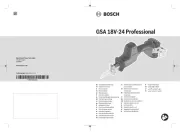
15 September 2025
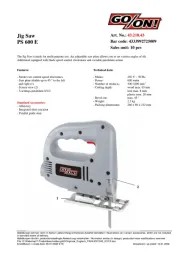
7 September 2025
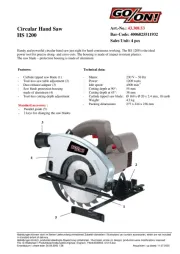
7 September 2025
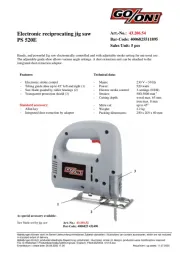
7 September 2025
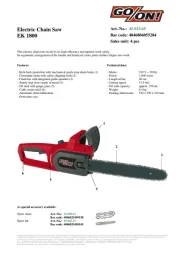
7 September 2025
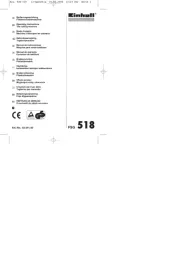
2 September 2025
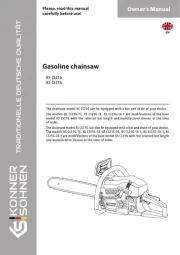
2 September 2025
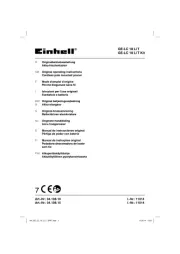
2 September 2025
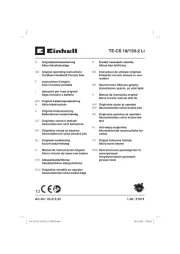
2 September 2025
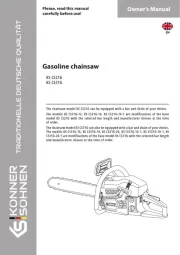
2 September 2025